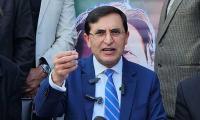As inflation reaches an adjusted 38 per cent across the country, it seems Pakistan is in the worst economic state it has ever been. There is a pronounced, feverish race to secure the IMF tranches, as they will lead to securing additional capital injections from the usual suspects.
Doom and gloom are being actively peddled by political pundits and commentators as the flavour of the year, and the public is up in arms about the rising commodity and fuel prices.
Pakistan has a young population of 100 million below 23, one of the largest youth bulges in the world. Roughly 64 per cent are between the age of 15 and 29. Below 15, nearly 22 million children are out of school. There are significant issues with retention, teacher training, infrastructure, and learning. The net result is a system which does not produce a globally and competitively viable workforce, which gets increasingly relegated, pinched, and pushed into the margins.
The predominantly young population in Pakistan is concerned with survival and disenfranchisement. Not innovation, invention, and entrepreneurship.
It is important to establish that the bulk of Pakistan’s youth is more concerned with daily subsistence and existence and not with the macro-outlook, long-term strategic ideals, or critical thinking, mostly through no fault of their own. The above can be leveraged to great effect by a political savvy and digitally robust team to drive national and provincial politics, and larger state agendas.
We have observed this with the TLP. We have observed this with the PTI. But we have not seen this with the PML-N.
The economic suicide in the early months of 2022 by providing the unrealistic, ill-fated, and forex-draining fuel subsidy was a minefield that the PML-N stepped into in their thirst for power and control. That minefield went off, landing the blame squarely on the fledging PML-N administration, instead of the economic mismanagement of the PTI. Building and peddling this narrative is cheap and easy.
Post hoc, ergo, propter hoc – after it, therefore, because of it. It is classic logical fallacy that has been wielded to great effect by the PTI. It has also not been countered or challenged effectively by the PML-N war machine, which is already successfully accused of being corrupt, and being a foreign puppet party.
Youth in Pakistan now feels that in addition to an education sector that does not prepare them for the real world, a job market that has resulted in 31 per cent of youth currently unemployed, a lack of technical and vocational training (despite hundreds of institutes catering to thousands of youths), and rising prices for everything from fuel to sugar is resulting in the need to see drastic change. We saw a precursor of this during the by-elections in Punjab on July 17, 2022.
A range of factors are not in Pakistan’s control.
Pakistan is at the mercy of the global fuel and food prices, partly as a direct result of the war in Ukraine. Climate change is another big factor, where Pakistan contributes to less than one per cent of GHG but is the eighth most affected country in the Climate Risk Index (CRI). The global debt crisis and skyrocketing interest rates are also not something that Pakistan can control. Exigent global events such as the pandemic and pressure built from defaulting sovereign states (such as Sri Lanka) are additional factors out of the ambit of Pakistan’s influence.
There are, however, a few things internally that are in Pakistan’s control. Specifically, these are vertical and horizontal accountability.
Horizontal accountability is marred by political expedience, appointments, and interference by the elite. Enamoured principally by rent-seeking in key industries (cement, steel, sugar, real-estate, etc.), they have failed to curb Pakistan’s unrealistic and unhealthy addition to imports. They have failed to bolster the export-sector in crucial areas (IT, pharmaceuticals, agriculture), instead choosing to gut industries in the name of short-term gains and short-sighted pettiness (despite comparatively improving export numbers).
FDI continues to decline, while remittances have reached an all-time high. Corruption, nepotism, and elite capture dominate the discourse, and our institutions for accountability are tools of political victimization and targeting than public service.
Vertical accountability comes in the form of voting. There needs to be a functional understanding on three core ideas. First, who is responsible for the current economic crisis (both in the short term – PTI, and in the long term – PML-N/PPP). Second, how Pakistan does not operate in a vacuum, and it has major international commitments and considerations that it must abide by. And third, that political continuity is necessary for the long term (irrespective of which lesser of the evils is in the driving seat). However, vertical accountability implies an informed electorate, and the bulk of our electorate is easily swayed by bite-sized, reductive messaging, rather than long-term strategic considerations.
And how can they be concerned with the long-term? Their principal concern is basic survival.
The writer is director for growth and strategy at Tabadlab Pakistan. He tweets @zeesalahuddin, and can be reached at:
zeeshan.salahuddin@gmail.com
Chinese philosopher Mencius prophesized 3000 years ago that state that does not employ worthy perishes
Over past two decades, rapid and often chaotic development has increasingly defined Islamabad's landscape
Donald Trump's entry into White House is going to be stormy
Most notable is dangerous surge in conflict at scale not seen since last world war
Coordinated attacks sent wave of insecurity across country, tarnished Pakistan's image globally
For now, IMF agreement provides essential cushion to help Pakistan return from the brink of Sri-Lanka-type default on...







